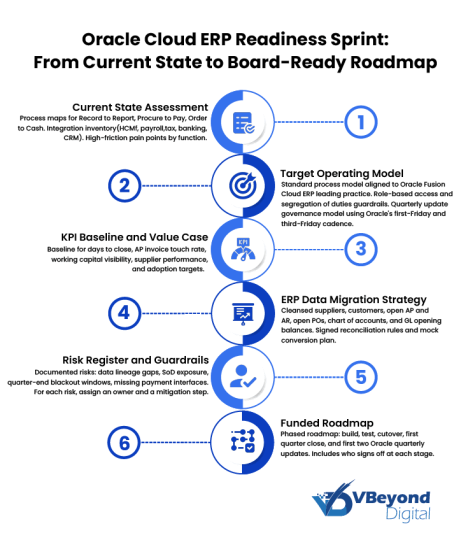Implementing Oracle Cloud ERP Services: A Step-by-Step Guide
Section
Table of Contents
- Why Oracle Cloud ERP, Why Now: Business Outcomes and Decision Framework1. Why Oracle Cloud ERP, Why Now: Business Outcomes and Decision Framework
- Readiness and Value Case: From Current State to Target Operating Model
- Reference Architecture and Integration Patterns
- Operate and Improve: Quarterly Updates, AI Features, and Value Realization
- Conclusion: Operate, Improve, Realize Value
- FAQs (Frequently Asked Question)
- Oracle cloud ERP implementation is a fundamental change to the finance operating model, rather than a mere system replacement.
- Oracle Fusion Cloud ERP updates are applied to the test environment on the first Friday and to production on the third Friday, allowing two weeks for regression testing and sign-off.
- Embedded AI like Intelligent Document Recognition reduces AP manual entry and improves working capital visibility.
- VBeyond Digital delivers KPI-driven readiness, Oracle Integration Cloud patterns, data migration control, and quarterly value tracking.
1. Why Oracle Cloud ERP, Why Now: Business Outcomes and Decision Framework
CIOs and transformation leaders are under pressure to standardize finance and operations, reduce manual work in core processes like payables and reporting, and supply leadership with reliable numbers in real time. Oracle Cloud ERP implementation directly targets those outcomes by combining modern financial controls, embedded AI, quarterly functional updates, and an operating model that shifts cost and upgrade effort away from internal IT.
Managed Services on Azure
When leaders sponsor an Oracle cloud ERP implementation, it is rarely about “moving to cloud” as an abstract goal. It is about specific financial and operational outcomes that must stand up in front of a board or an audit committee.
The recurring targets we see across finance, procurement, supply chain, and IT are listed below. These outcomes are backed by current Oracle Fusion Cloud ERP and Oracle Financials Cloud capabilities, including embedded AI, standard financial control flows, and always-current releases.
1. Faster and cleaner period close – Oracle Fusion Cloud ERP provides integrated subledgers, close dashboards, and drill-down from general ledger to transaction detail. Controllers can monitor close status across multiple entities in one place, resolve exceptions quickly, and reduce manual reconciliations. This supports a faster and more predictable period close and gives executives earlier visibility to actuals.
2. Real-time financial visibility for leadership – Oracle Cloud ERP and Oracle Fusion Cloud ERP expose live financial data, operational metrics, and period close status through dashboards and self-service reporting, instead of static spreadsheets that are days out of date.
3. Stronger working capital control – Oracle Fusion Cloud ERP includes intelligent document recognition for supplier invoices. The system extracts key invoice data from emails, creates draft payables records automatically, and predicts account code combinations, which removes manual rekeying and lowers the risk of miscoding.
4. Standard process adoption across entities – Oracle Fusion Cloud ERP ships with leading practice process flows for finance, procurement, and supply chain. These are kept current through Oracle’s quarterly update model, which continuously introduces new features across areas such as procure-to-pay and record-to-report without requiring disruptive major upgrades.
5. Lower infrastructure overhead and support load on IT – Oracle Cloud ERP runs on Oracle-managed infrastructure and ships as a subscription service. Internal teams no longer carry out the burden of sizing hardware, applying patches, planning multi-year upgrade programs, or owning disaster recovery infrastructure for ERP.
6. Better demand and supply planning when finance and supply chain share a common platform – Oracle Fusion Cloud ERP, combined with Oracle supply chain modules, supports integrated planning, procurement, inventory, and financial impact analysis in a connected model. This results in more accurate demand and supply planning, tighter control of inventory positions, and better visibility into supplier performance.
Start your Oracle value run
2. Readiness and Value Case: From Current State to Target Operating Model
Oracle Cloud ERP implementation only succeeds when it is grounded in current state facts, a clear target operating model, quantifiable KPIs, and a managed risk profile. This is not a tooling discussion. It is an operating model decision that affects how finance closes the books, how procurement manages spend, how operations manages supply, and how IT supports quarterly change cycles.
We reference current Oracle guidance on readiness, quarterly update discipline, role-based access and segregation of duties, AI-driven invoice processing, and KPI-driven value realization in Oracle Fusion Cloud ERP and Oracle Cloud ERP Services.
2.1 Current state assessment
The readiness phase begins with an honest view of how work gets done today. Oracle ERP implementation programs that skip or underinvest in this stage tend to absorb late-stage surprises in data, integrations, compliance, or blackout windows.
1. Map core finance and operations processes by business unit – Typical flows include record to report, procure to pay, order to cash, inventory management, supplier onboarding, project accounting, and demand planning. We document how each step actually runs as of today, not how the standard operating procedure claims it runs.
2. Map pain points and bottlenecks – We capture friction in the areas that matter to CFOs and COOs: close cycle timing, days payable outstanding, receivables leakage, PO cycle time, supplier master quality, subledger reconciliation effort, and audit exceptions.
Oracle publishes Intelligent Document Recognition (IDR) in Oracle Fusion Cloud. ERP automatically extracts invoice information from emailed documents, builds draft payables invoices, and predicts accounting combinations.
Oracle publishes Intelligent Document Recognition (IDR) in Oracle Fusion Cloud. ERP automatically extracts invoice information from emailed documents, builds draft payables invoices, and predicts accounting combinations.
3. Catalog extensions, reports, and macros – We list custom reports, spreadsheets that act like shadow subledgers, RPA routines, and any database procedures that feed finance. Each of these artifacts represents either:
a. A candidate to retire because Oracle Cloud ERP already addresses it; or
b. A controlled exception that must be carried forward because of legal, regulatory, or commercial reasons.
Treating every spreadsheet-driven workaround as sacred is one of the fastest paths to scope creep in an Oracle cloud ERP implementation.
4. Inventory upstream and downstream systems – The readiness sprint builds an integration inventory that covers HCM, payroll, bank payment interfaces, tax engines, customer and supplier data feeds, CRM order capture, and data platforms used for analytics. This is the starting point for Oracle Integration Cloud planning. Oracle Integration Cloud is used to move data between Oracle Fusion Cloud ERP and external systems using event-based messages, REST services for real time cases, and file-based batch flows when high volume or regulatory formatting is involved.
6. Document quarter end, yearend, and blackout windows – Production finance is not a lab. Close, tax filing, audit prep, and external reporting create non-negotiable blackout windows. We capture these windows up front so that cutover, data migration rehearsals, and regression testing do not collide with those events. This is critical because Oracle Fusion Cloud ERP follows a quarterly update cadence, with non-production environments updated first and production updated roughly two weeks later. That gap is intended for regression testing of critical business flows.
2.2 Target operating model
The next step is to define how finance, procurement, supply chain, and IT will work once Oracle Cloud ERP Services are in place. This target model is not a slide. It is a contract between business and IT about how decisions will be made going forward.
Principles of the target operating model:
1. Standardize on Oracle Fusion Cloud ERP leading practice flows wherever possible – Oracle Fusion Cloud ERP and Oracle ERP implementation guidance includes prebuilt process flows for record to report, procure to pay, order to cash, and related finance and supply chain functions. These flows are maintained by Oracle and improved with each quarterly update.
The program should default to those flows as the standard.
Only two types of variances are acceptable:
a. A variance that is mandated by law or regulation in each jurisdiction.
b. A variance that provides a clear commercial advantage, for example, a pricing or revenue recognition model that is central to your business model.
Everything else becomes technical debt and cost.
2. Central chart of accounts, controlled reference data, clean supplier and customer master – Oracle Cloud ERP Services depends on a consistent chart of accounts and consistent master data in order to report in real time across business units. The target model defines who owns that structure going forward, how changes are requested, and how they are validated.
3. Quarter by quarter feature intake model – Oracle Fusion Cloud ERP follows a predictable quarterly update cycle. Oracle applies new capabilities in a non-production environment first, then production roughly two weeks later.
The target model defines who reviews those new features, who regression tests critical flows, who approves adoption of new capabilities, and who updates training content and internal controls.
4. Role–based access, continuous audit, and SoD control – Oracle Cloud ERP Services, paired with Oracle Fusion Cloud Risk Management and Compliance, supports segregation of duties analysis, user activity monitoring, and access governance.
5. Data and analytics operating model – Oracle Fusion Cloud ERP offers operational reporting and analytics through Oracle Transactional Business Intelligence and can replicate data outward for broader analytics and planning.

3. Reference Architecture and Integration Patterns
A successful Oracle cloud ERP implementation needs more than module configuration. It needs an enterprise-grade reference architecture that covers identity and access control, environments for build and test, integration patterns using Oracle Integration Cloud, logging and monitoring, data access, and disaster recovery expectations.
This section describes how CIOs, CTOs, and transformation leaders should structure Oracle ERP implementation and Oracle Cloud Migration so that finance and operations can run with confidence on day one and quarters after going live.
3.1 Core solution components
When we design the target state for Oracle Fusion Cloud ERP, we work with five building blocks.
1. Oracle Fusion Cloud ERP modules in scope – These typically include General Ledger, Payables, Receivables, Procurement, Projects, and Inventory or Supply Chain where required. Oracle Fusion Cloud ERP delivers these modules as SaaS, with quarterly functional updates. Stage environments are updated first, and production updates follow two weeks later.
2. Identity and Access – Oracle is moving Fusion Applications identity to Oracle Cloud Infrastructure Identity and Access Management, which supports centralized control of authentication, single sign on, multifactor authentication, and user lifecycle management in the Oracle Cloud ERP Services environment.
3. Logging, monitoring, and audit – Oracle Fusion Cloud ERP records activity for finance events such as invoice entry, supplier master changes, and journal posting. Combined with Oracle Risk Management and Compliance, this supports review of privileged activity and detection of segregation of duties conflicts.
4. Non–production tiers – Oracle provides multiple pods or environments such as stage and test. The stage pod receives Oracle quarterly updates first, on what Oracle describes as the first Friday of the quarterly update month. Production receives the same update roughly two weeks later, which is typically the third Friday.
5. Disaster recovery posture – Oracle Fusion Cloud ERP, delivered as SaaS, is backed by Oracle disaster recovery processes that replicate production data and application services to a secondary location for business continuity in the event of an outage.
3.2 Integration inventory
Every Oracle ERP implementation must account for inbound and outbound flows that are business critical. Missing one can stall a cutover. The minimum integration inventory usually includes:
1. Payroll and HCM – Payroll costing and labor distribution must be posted to the general ledger. If HCM or payroll is not on Oracle Fusion Cloud, Oracle Integration Cloud or an equivalent integration layer needs to move summarized payroll results into Oracle Fusion Cloud ERP for accounting.
2. Banking and payments – Oracle Fusion Cloud ERP Payables produces payment files that must match bank format requirements. Inbound bank statements feed cash management and reconciliation. Oracle Integration Cloud supports secure file–based and API–based bank connectivity for these processes.
3. Tax engines – Many finance teams connect to external tax engines for indirect tax, withholding tax, or jurisdiction–specific rules. These systems must receive transaction data in near real time or in scheduled batches and return calculated tax values back to Oracle Fusion Cloud ERP. Oracle Integration Cloud supports both REST and scheduled batch styles for this pattern.
4. CRM and order capture – Order to Cash is often split between a commercial front end and Oracle Fusion Cloud ERP. Orders, pricing, and customer master data need to be moved into Receivables and Order Management. Oracle Integration Cloud supports real-time REST services for transactional needs where timing is critical, and batch style integrations where volume is high, but timing is less strict.
5. Data platforms and analytics – Oracle Fusion Cloud ERP provides operational reporting and analytics through Oracle Transactional Business Intelligence. For consolidated analytics across finance, supply chain, and sales, many clients replicate selected ERP data to an enterprise data platform.
4. Operate and Improve: Quarterly Updates, AI Features, and Value Realization
Oracle cloud ERP implementation is not finished at go live. The operating model after go live is what determines whether you get sustained value in finance, procurement, and supply chain, or whether the program stalls and becomes another heavy platform that business users work around.
1. Quarterly updates
Oracle Fusion Cloud ERP and related Oracle Cloud ERP Services follow a fixed quarterly update model. This is not optional and cannot be deferred indefinitely. The way you plan for and absorb this cadence is one of the most important ERP Best Practices after Oracle Cloud Migration.
2. AI and automation in Oracle Fusion Cloud ERP
Oracle has embedded AI-driven features directly into Oracle Fusion Cloud ERP and Oracle Cloud ERP Services. Oracle publishes that many of these capabilities, including Intelligent Document Recognition in Accounts Payable, predictive account coding, and digital assistants, can be activated without buying separate third-party tooling. These AI features exist to reduce manual AP touch time, support cash control, and speed financial close.
5. Conclusion: Operate, Improve, Realize Value
Oracle cloud ERP implementation is an operating model, not a one-time cutover. Oracle Fusion Cloud ERP delivers quarterly updates: test environments are updated on the first Friday of the cycle and production two weeks later, which Oracle states is a mandatory cadence for new features, fixes, and security.
You are expected to regression test core finance flows, validate Oracle Integration Cloud interfaces, review role changes, and decide which new AI-driven capabilities like Intelligent Document Recognition for Payables will go live.
VBeyond Digital helps you get Oracle Fusion Cloud ERP live, stable, and continuously improving without guesswork. We build the value case, stand up the operating model, map and migrate critical data, design integration through Oracle Integration Cloud, and run the quarterly update rhythm that Oracle requires so production stays stable and auditable.
FAQs (Frequently Asked Question)
Oracle Cloud ERP implementation is the transition of finance, procurement, and operations processes into Oracle Fusion Cloud ERP, including data migration, role and access design, critical integrations through Oracle Integration Cloud, and readiness for Oracle’s mandatory quarterly updates.
Typical timelines range from a few months focused scope to 12 to 18 months or more for multi-entity rollouts. Duration depends on module breadth, data quality, integrations, and change readiness in finance and operations.
Programs move through planning and design, configuration, integration build, ERP Data Migration Strategy execution with mock loads and reconciliation, user and process testing, cutover, and go live. This is followed by quarterly update operations using Oracle’s first–Friday and third-Friday update cycle.
The most common risks are poor data quality; missing or fragile integrations to banking, tax, CRM or payroll; segregation–of–duties gaps in access design; and lack of a repeatable process for Oracle’s mandatory quarterly updates between stage and production.
Lead with measurable outcomes like days to close and AP cycle time, adopt standard Oracle Fusion Cloud ERP processes, run multiple test migrations with business sign off, document every critical interface in Oracle Integration Cloud, and treat quarterly updates as an ongoing controlled cycle.




